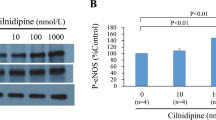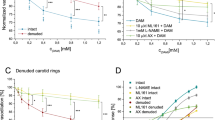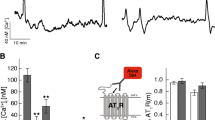Abstract.
The main in-vivo metabolite of amiodarone, N-desethylamiodarone (DEAM), possesses clinically relevant class-III antiarrhythmic and vasodilator activities. Vasodilation by DEAM is endothelium dependent and involves a sustained and biphasic increase in cytosolic free Ca2+ concentration ([Ca2+]i). The aims of this study were to explore the mechanisms mediating the DEAM-induced increase in [Ca2+]i in endothelial cells and to determine whether this increase in [Ca2+]i was associated with altered cell proliferation. Cultured bovine aortic endothelial cells were loaded with the Ca2+-sensitive fluorescent dye Fura-2/AM, and [Ca2+]i measured spectrofluorimetrically. DEAM increased [Ca2+]i concentration dependently (EC50 approximately 6 µM) both in the presence and absence of extracellular Ca2+. In the presence of extracellular Ca2+, the response of [Ca2+]i to DEAM (10 µM) consisted of an initial rise to a plateau followed by a second increase to micromolar levels. The initial plateau was reduced by the endoplasmic reticulum Ca2+-ATPase inhibitor thapsigargin (200 nM) and by the antioxidant ascorbic acid (100 µM). The initial rate of rise in [Ca2+]i was decreased by blocking mitochondrial Ca2+ release with cyclosporine A (1 µM). Under Ca2+-free conditions, the response of [Ca2+]i to DEAM (10 µM) was also biphasic, consisting of an initial transient peak and a second slow increase. When extracellular Ca2+ was restored, [Ca2+]i rose to micromolar concentrations. The initial peak was abolished by thapsigargin, but not altered by ascorbic acid or cyclosporine A. Both the second [Ca2+]i increase and that due to restoring extracellular Ca2+ were reduced by ascorbic acid but not affected by thapsigargin or cyclosporine A. The DEAM-induced generation of free radicals and sustained increase in [Ca2+]i might alter cell proliferation and endothelial cell proliferation was indeed concentration-dependently inhibited by DEAM (IC50 approximately 2.5 µM). In conclusion, the DEAM-induced [Ca2+]i increase in endothelial cells is due to Ca2+ influx from the extracellular space and to Ca2+ release from endoplasmic reticulum and mitochondria and involves enhanced generation of free radicals.
Similar content being viewed by others
Author information
Authors and Affiliations
Additional information
Electronic Publication
Rights and permissions
About this article
Cite this article
Himmel, H., Dobrev, D., Grossmann, M. et al. N-desethylamiodarone modulates intracellular calcium concentration in endothelial cells. Naunyn-Schmied Arch Pharmacol 362, 489–496 (2000). https://doi.org/10.1007/s002100000301
Received:
Accepted:
Issue Date:
DOI: https://doi.org/10.1007/s002100000301




